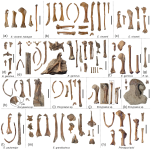albertonykus
Well-known member
Mayr, G. and A.C. Kitchener (2024)
New fossils of Eocypselus and Primapus from the British London Clay reveal a high taxonomic and ecological diversity of early Eocene swift-like apodiform birds
Ibis (advance online publication)
doi: 10.1111/ibi.13323
We describe new specimens and species of apodiform birds from the early Eocene London Clay of Walton-on-the Naze (Essex, UK). In addition to multiple partial skeletons of Eocypselus vincenti Harrison, 1984, three new species of Eocypselus are described as Eocypselus geminus, sp. nov., Eocypselus paulomajor, sp. nov. and Eocypselus grandissimus, sp. nov. The previously unknown quadrate of Eocypselus shares a characteristic derived morphology with the quadrate of the Aegothelidae, Hemiprocnidae and Apodidae, whereas the quadrate of the Trochilidae is very different. We also report a striking disparity of the shapes of the axis vertebra of apodiform birds, which is likely to be of functional significance. Eocypselus and extant Hemiprocnidae and Cypseloidini (Apodidae) exhibit the plesiomorphic morphology, whereas a derived shape characterizes extant Aegothelidae, Apodini and Trochilidae. Furthermore, we describe the first partial skeleton of the earliest aegialornithid species, Primapus lacki Harrison & Walker, 1975, which was previously only known from the humeri of the type series that stem from different sites of the London Clay. The apodiform birds from Walton-on-the-Naze show a considerable taxonomic and ecomorphological diversity, and whereas Eocypselus may have inhabited forest edges and caught insects by sallying flights from perches, Primapus probably was a fast-flying and more aerial bird.
New fossils of Eocypselus and Primapus from the British London Clay reveal a high taxonomic and ecological diversity of early Eocene swift-like apodiform birds
Ibis (advance online publication)
doi: 10.1111/ibi.13323
We describe new specimens and species of apodiform birds from the early Eocene London Clay of Walton-on-the Naze (Essex, UK). In addition to multiple partial skeletons of Eocypselus vincenti Harrison, 1984, three new species of Eocypselus are described as Eocypselus geminus, sp. nov., Eocypselus paulomajor, sp. nov. and Eocypselus grandissimus, sp. nov. The previously unknown quadrate of Eocypselus shares a characteristic derived morphology with the quadrate of the Aegothelidae, Hemiprocnidae and Apodidae, whereas the quadrate of the Trochilidae is very different. We also report a striking disparity of the shapes of the axis vertebra of apodiform birds, which is likely to be of functional significance. Eocypselus and extant Hemiprocnidae and Cypseloidini (Apodidae) exhibit the plesiomorphic morphology, whereas a derived shape characterizes extant Aegothelidae, Apodini and Trochilidae. Furthermore, we describe the first partial skeleton of the earliest aegialornithid species, Primapus lacki Harrison & Walker, 1975, which was previously only known from the humeri of the type series that stem from different sites of the London Clay. The apodiform birds from Walton-on-the-Naze show a considerable taxonomic and ecomorphological diversity, and whereas Eocypselus may have inhabited forest edges and caught insects by sallying flights from perches, Primapus probably was a fast-flying and more aerial bird.





